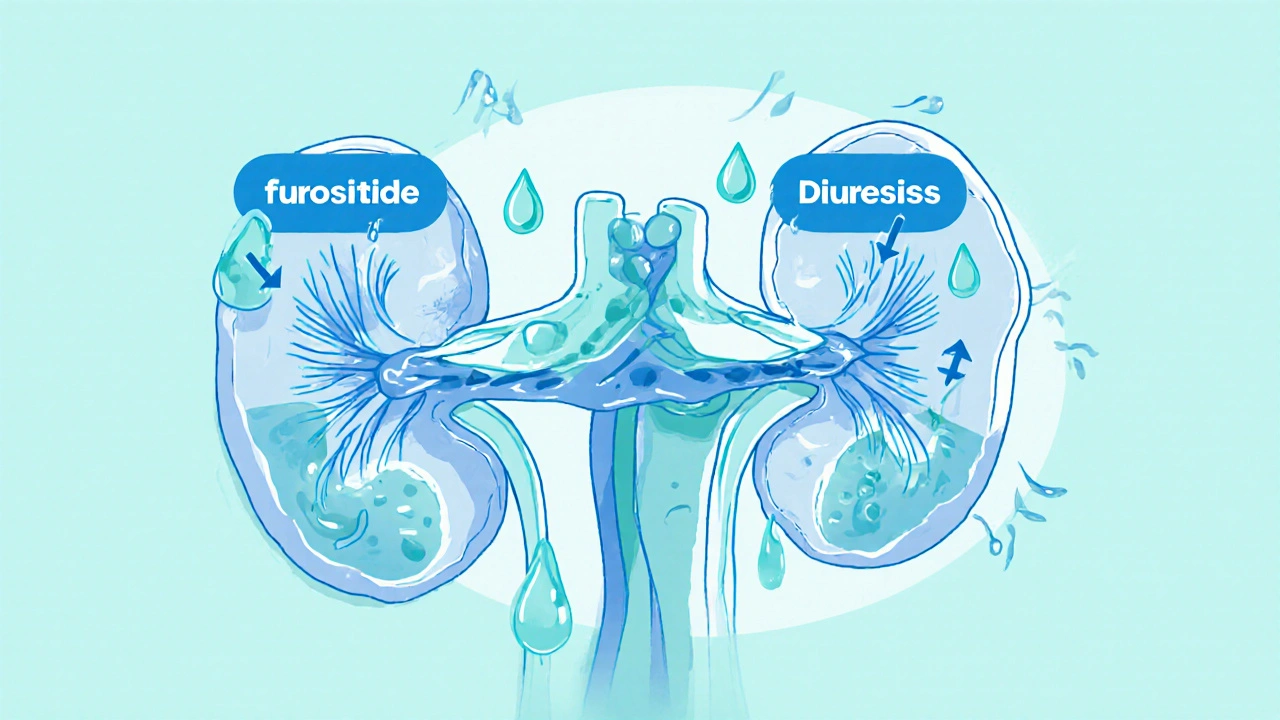Diuretic Selection Tool
Select your main condition or priority
Let us know about your situation to get more personalized recommendations
When your body holds onto too much fluid-swollen ankles, shortness of breath, or unexplained weight gain-it’s often because your kidneys aren’t flushing out salt and water like they should. That’s where diuretics come in. Furosemide, sold under the brand name Lasix, has been the go-to for decades. But it’s not the only option. In fact, for many people, switching to another diuretic can mean fewer side effects, better control, or even lower costs. So how do you know if furosemide is still the right choice-or if an alternative might work better?
What furosemide actually does
Furosemide is a loop diuretic. That means it works in the loop of Henle, a part of the kidney that handles most of your body’s salt and water balance. It blocks the reabsorption of sodium and chloride, which pulls water out with it. The result? You pee more. A lot more. That’s why it’s used for heart failure, liver cirrhosis, kidney disease, and high blood pressure.
Most people take it once or twice a day. A typical starting dose is 20 to 40 mg. But effectiveness varies. Some people need 100 mg or more. Others get by on 10 mg. It kicks in within 30 to 60 minutes, peaks in about two hours, and lasts four to six hours. That short window can be a problem-especially if you’re trying to avoid nighttime bathroom trips.
Why people look for alternatives
Even though furosemide works, it’s not perfect. Many patients report muscle cramps, dizziness, or low potassium. Some develop hearing problems, especially at high doses or with kidney issues. Others find they need to take it twice daily, which disrupts sleep or daily routines.
Cost is another factor. While generic furosemide is cheap, prices have crept up in recent years. In the UK, a 30-day supply can cost £5 to £12 depending on the pharmacy. Alternatives like torsemide or spironolactone can be just as effective-and sometimes cheaper, especially with prescription savings programs.
Then there’s the issue of resistance. After months or years of use, some patients find furosemide doesn’t work as well as it used to. That’s not always because the drug failed. It’s often because the body adapted. Switching to a different diuretic can reset the system.
Hydrochlorothiazide: The thiazide alternative
Hydrochlorothiazide (HCTZ) is a thiazide diuretic. It works lower down in the kidney than furosemide, so it’s milder. It’s often the first choice for high blood pressure alone-especially in older adults.
Compared to furosemide, HCTZ has a longer half-life. One pill a day is usually enough. It’s less likely to cause sudden drops in blood pressure or dehydration. But it doesn’t remove as much fluid. That makes it weaker for severe swelling, like in advanced heart failure.
It’s also better for potassium levels. Furosemide drains potassium fast. HCTZ does too, but slower. Still, many people on HCTZ need a potassium supplement. It’s often combined with other drugs, like ACE inhibitors, for better blood pressure control.
Cost-wise, HCTZ is usually cheaper than furosemide. A 30-day supply often costs under £3. If your main issue is mild fluid retention or high blood pressure without major swelling, HCTZ might be a simpler, safer bet.
Spironolactone: The potassium-sparing option
Spironolactone is different. It’s not a loop or thiazide diuretic. It’s an aldosterone antagonist. That means it blocks a hormone that tells your kidneys to hold onto salt and water. It’s slow to work-takes days to show results-but it’s powerful for long-term control.
It’s often used with furosemide in heart failure patients. Why? Because furosemide knocks out potassium, and spironolactone keeps it in. That combo reduces hospital readmissions and improves survival rates. Studies show it cuts death risk by up to 30% in severe heart failure.
But it’s not for everyone. Men can get breast tenderness or reduced libido. Women might notice irregular periods. It can raise potassium levels too much, especially in people with kidney disease. That’s why blood tests are required every few months.
Cost is low-under £5 for 30 tablets. If you’re on long-term diuretic therapy and need to protect your heart, spironolactone isn’t just an alternative. It’s often essential.
Bumetanide: The stronger loop diuretic
Bumetanide is another loop diuretic, like furosemide. But it’s about 40 times more potent. A 1 mg dose of bumetanide equals about 40 mg of furosemide. That means smaller pills, less bulk, and sometimes fewer side effects.
It’s absorbed more reliably in people with poor digestion or swelling in the gut-common in advanced heart failure. Furosemide can be erratic in these cases. Bumetanide isn’t. That’s why it’s often chosen for hospitalized patients or those who’ve stopped responding to furosemide.
The downside? It’s shorter acting. You might need to take it twice a day. And it can still cause low potassium, low blood pressure, or dizziness. But for patients who need a strong, reliable kick, it’s a top pick.
Price is similar to furosemide. But because you take less of it, some pharmacies offer it at a discount. It’s not first-line, but it’s a lifesaver when furosemide isn’t cutting it.
Torsemide: The long-acting contender
Torsemide is the newest of the loop diuretics. It lasts longer-up to 12 hours. That means one dose a day is often enough. It’s also absorbed more consistently, even in people with poor gut function.
Studies show torsemide reduces hospital readmissions more than furosemide in heart failure patients. One trial found a 35% lower risk of hospitalization over 12 months. It also has a lower chance of causing hearing loss, which matters if you’re on high doses long-term.
It’s more expensive than furosemide, but not by much. In the UK, a 30-day supply runs about £8 to £10. Many NHS prescriptions now default to torsemide for new heart failure patients. If you’re looking for something more reliable, longer-lasting, and better studied for outcomes, torsemide is the most compelling alternative.
Choosing the right one: A quick guide
Here’s how to think about it:
| Diuretic | Strength | Dosing Frequency | Best For | Key Risk | Typical UK Cost (30-day) |
|---|---|---|---|---|---|
| Furosemide | High | 1-2 times/day | Acute swelling, hospital use | Low potassium, hearing issues | £5-£12 |
| Hydrochlorothiazide | Mild | Once/day | High blood pressure, mild edema | Low potassium, dehydration | £2-£5 |
| Spironolactone | Moderate | Once/day | Heart failure, long-term use | High potassium, hormonal side effects | £3-£7 |
| Bumetanide | Very high | 1-2 times/day | Resistant edema, poor absorption | Low potassium, dizziness | £6-£10 |
| Torsemide | High | Once/day | Heart failure, consistent control | Low potassium, rare hearing loss | £8-£10 |

When to ask your doctor about switching
You don’t need to switch just because something’s new. But here are signs it might be time:
- You’re still swollen after a week on furosemide
- You’re waking up three or more times at night to pee
- Your potassium levels keep dropping, even with supplements
- You’ve noticed ringing in your ears or hearing changes
- You’re taking multiple pills a day and it’s hard to keep track
- Your doctor says your heart failure is getting worse
If any of these sound familiar, talk to your GP or cardiologist. Don’t stop or change your dose on your own. But do ask: "Is there a better option for me?"
What most patients don’t realize
Diuretics aren’t magic pills. They don’t fix the root problem-they just manage symptoms. If you have heart failure, kidney disease, or liver cirrhosis, the real work is in treating the underlying condition. Diuretics are just one tool.
Also, salt intake matters more than the drug. Even the strongest diuretic can’t outwork a high-salt diet. Most people don’t realize how much salt is hidden in bread, soup, sauces, and processed snacks. Cutting salt can reduce your diuretic dose by half.
And hydration? You still need to drink water. Dehydration from too much peeing can hurt your kidneys. The goal isn’t to stop fluid retention completely-it’s to find the balance where you feel better without risking harm.
Can I switch from furosemide to torsemide on my own?
No. Switching diuretics requires medical supervision. Torsemide is more potent and longer acting, so your dose needs to be adjusted carefully. Going from 40 mg furosemide to 10 mg torsemide might sound like a 1:4 ratio, but absorption and metabolism vary between people. Your doctor will start low and monitor your electrolytes and kidney function.
Is spironolactone safe for men?
Yes, but with caveats. Spironolactone can cause breast enlargement or tenderness in men, and sometimes reduced sex drive. These effects are usually mild and reversible if you stop the drug. For men with heart failure, the benefits-like lower risk of death-far outweigh the risks. Your doctor may start with a low dose (12.5-25 mg) and check for side effects after a few weeks.
Which diuretic is best for high blood pressure alone?
Hydrochlorothiazide is usually the first choice. It’s proven to reduce stroke and heart attack risk in long-term studies. Furosemide is too strong for most people with just high blood pressure-it can cause excessive fluid loss and low blood pressure. Unless you also have swelling or heart failure, HCTZ is simpler and safer.
Do any of these alternatives cost less than furosemide?
Yes. Hydrochlorothiazide is often the cheapest, usually under £5 for a month’s supply. Spironolactone is also low-cost. Torsemide and bumetanide are slightly more expensive, but many pharmacies offer them at reduced prices through NHS prescription prepayment certificates. Always ask your pharmacist about savings options.
Can I take two diuretics together?
Yes, and it’s common. Many heart failure patients take furosemide or torsemide with spironolactone. This combo reduces fluid overload while protecting potassium levels. Sometimes, a low-dose thiazide like HCTZ is added for extra effect. But this increases the risk of dehydration and electrolyte imbalance, so regular blood tests are required.
What to do next
If you’re on furosemide and feeling okay, there’s no need to change. But if you’re struggling with side effects, frequent dosing, or poor results, ask your doctor about alternatives. Torsemide and spironolactone are now recommended in UK heart failure guidelines over furosemide for many patients. Hydrochlorothiazide remains the standard for simple hypertension.
Keep a journal: note your weight, swelling, energy levels, and bathroom habits. Bring it to your next appointment. That’s the best way to tell if a switch is working-or if you need a different approach altogether.







14 Comments
giri pranata
Man, I switched from furosemide to torsemide last year after my doc told me my kidneys were getting tired of the old stuff. One pill a day and I don’t wake up at 3am anymore. Best decision ever. Also, cut my salt like crazy-no more canned soups or soy sauce. My ankles actually look normal now. 😊
Stuart Rolland
Look, I’ve been on diuretics since my heart attack in 2018, and let me tell you, the whole furosemide thing is a relic. I tried everything-HCTZ made me dizzy, spironolactone gave me boobs (not cool, bro), but torsemide? That’s the golden child. Longer half-life, consistent absorption, and honestly, my cardiologist said it’s now the gold standard in Canada for HFpEF. And yeah, it costs a bit more, but if you’re on the NHS or have good insurance, they’ll cover it. Also, please stop eating processed food. Your kidneys aren’t superheroes. They’re just trying to survive your lunch.
Kent Anhari
As someone who moved from the US to India and had to navigate both healthcare systems, I can say this: furosemide is still widely used here because it’s cheap and available. But in rural clinics, they don’t even check potassium levels. That’s dangerous. Torsemide and spironolactone are better, but access is uneven. If you’re in a country with limited meds, talk to your pharmacist-they often know about patient assistance programs. Also, salt isn’t the enemy. It’s the *hidden* salt in chutneys, pickles, and roadside snacks that kills you.
Charlos Thompson
Oh great. Another ‘pharma-sponsored’ blog post telling you to switch drugs because the company paid for the study. Torsemide? Sure. Let me guess-Pfizer’s new favorite. And don’t even get me started on spironolactone being ‘essential.’ Sounds like they’re just trying to sell you more pills. Meanwhile, your doctor’s got a new Tesla. 💸
Peter Feldges
While I appreciate the clinical thoroughness of this post, I must respectfully assert that the implicit assumption that pharmacological substitution alone constitutes optimal therapeutic management is both reductive and potentially hazardous. The physiological homeostasis of fluid balance is a multivariate system influenced by circadian rhythm, dietary sodium kinetics, and renal perfusion dynamics. Therefore, the notion that one diuretic is categorically superior without individualized titration and biomarker surveillance is, in my professional estimation, epistemologically unsound. Furthermore, the omission of renal angiotensin-aldosterone axis modulation as a confounding variable in the cost-benefit analysis is concerning.
Ash Damle
spironolactone gave me boobs but also saved my life so i dont care lol my doc said its like 30% less chance of dying so i take it with my coffee and dont think twice. also cut out bread and i feel way better. no more puffy face in the morning. 🙌
Tanya Willey
They’re all poison. Furosemide? Made by Big Pharma to keep you hooked. Torsemide? Same thing. Spironolactone? It’s a hormone disruptor-they use it to castrate animals. And don’t even get me started on the salt conspiracy. They put fluoride in the water too. You think this is about your kidneys? No. It’s about control. 🧪👁️
sarat babu
WHY DOES NO ONE TALK ABOUT HOW FUROSEMIDE MADE ME SO DEHYDRATED I THOUGHT I WAS GOING TO DIE?!?!?! I WAS PEEDING EVERY 20 MINUTES AND MY LEGS WERE CRAMPING LIKE I WAS IN A HORROR MOVIE!!! 😭 I switched to torsemide and now I sleep through the night and I’m not a zombie!! THANK YOU GOD!! 🙏🙏🙏
Wiley William
Yeah right. Torsemide is ‘better’? Tell that to the 500 people in the 2018 JAMA study who had worse outcomes. This whole thing is a scam. Furosemide works fine. You just need to take more. And if you’re complaining about hearing loss, maybe you’re just listening to too much loud music. Stop whining and take your pills like a man.
Richard H. Martin
AMERICA: We have the best healthcare in the world. Also, we charge $400 for a pill that costs $0.10 to make. Spironolactone? $8 in the UK. $120 here. Why? Because we’re a nation of greedy CEOs and overpaid doctors. I’m moving to Canada. And I’m bringing my diuretics with me.
Tim H
i was on furosemide for 3 years and my dr said switch to bumetanide but i thought it was gonna be more expensive but it was actually cheaper and i only take 0.5mg now instead of 80mg of furosemide and i dont even need potassium pills anymore?? is this real?? i think my dr made a mistake but im not complaining lol
Umesh Sukhwani
It is imperative to underscore that diuretic therapy must be individualized with meticulous attention to electrolyte homeostasis, renal function, and comorbid conditions. The comparative efficacy of torsemide over furosemide in heart failure has been demonstrated in multiple randomized controlled trials, including the SOCRATES-REDUCED study. However, accessibility and cost remain significant barriers in low-resource settings. I encourage all patients to maintain a daily fluid and weight diary, and to consult with a nephrologist or cardiologist before altering regimens. Safety and sustainability must precede convenience.
Richard Kang
Okay but have you considered that maybe your body just needs a BREAK from diuretics?? Like… what if you didn’t need them at all?? What if you just needed to eat more kale and do yoga?? I tried stopping all meds for 2 weeks and my swelling went down. I’m now on a 100% raw food diet. My doctor hates me. I don’t care. 🌱🧘♂️
Rohit Nair
I’m from rural India and we don’t have easy access to torsemide or spironolactone. My doctor gave me furosemide and told me to drink coconut water and eat bananas every day. It’s not perfect, but it works. I also walk 5km every morning. No fancy pills, just simple things. If you’re lucky enough to have alternatives, use them. But don’t forget that lifestyle matters more than the brand name.